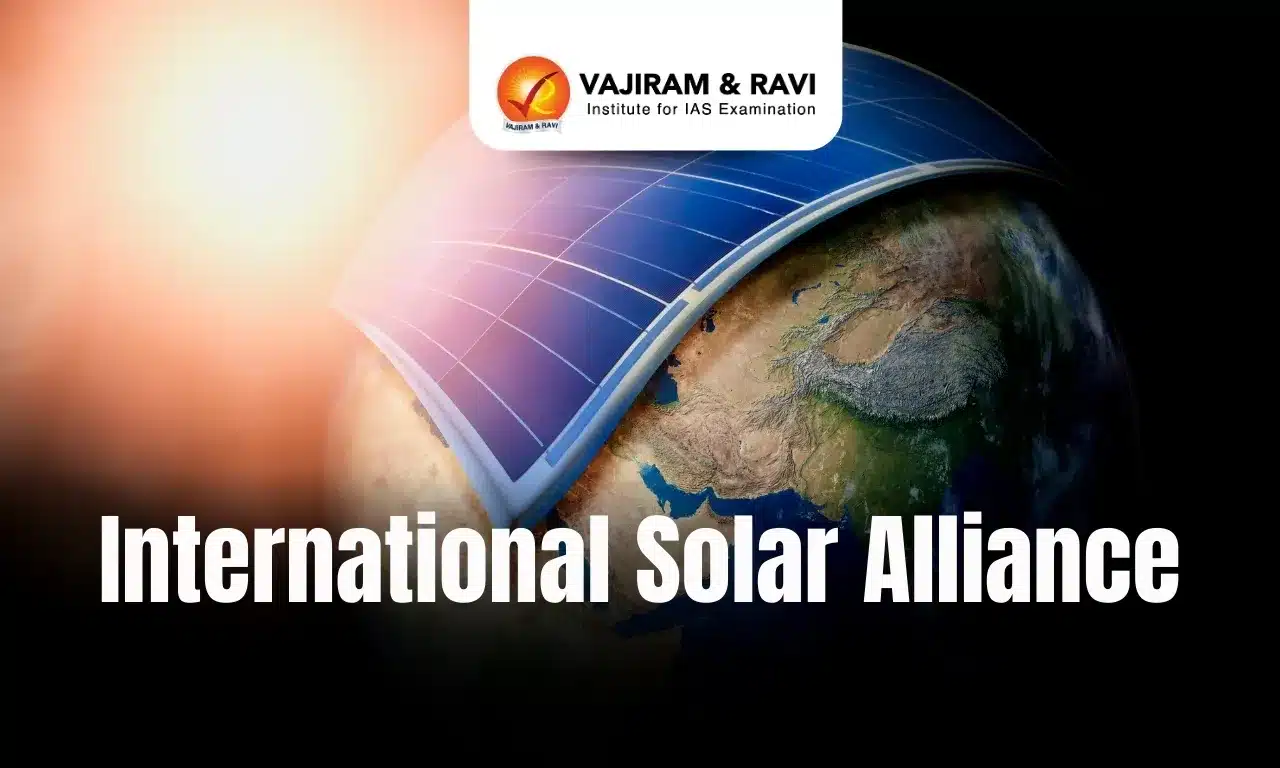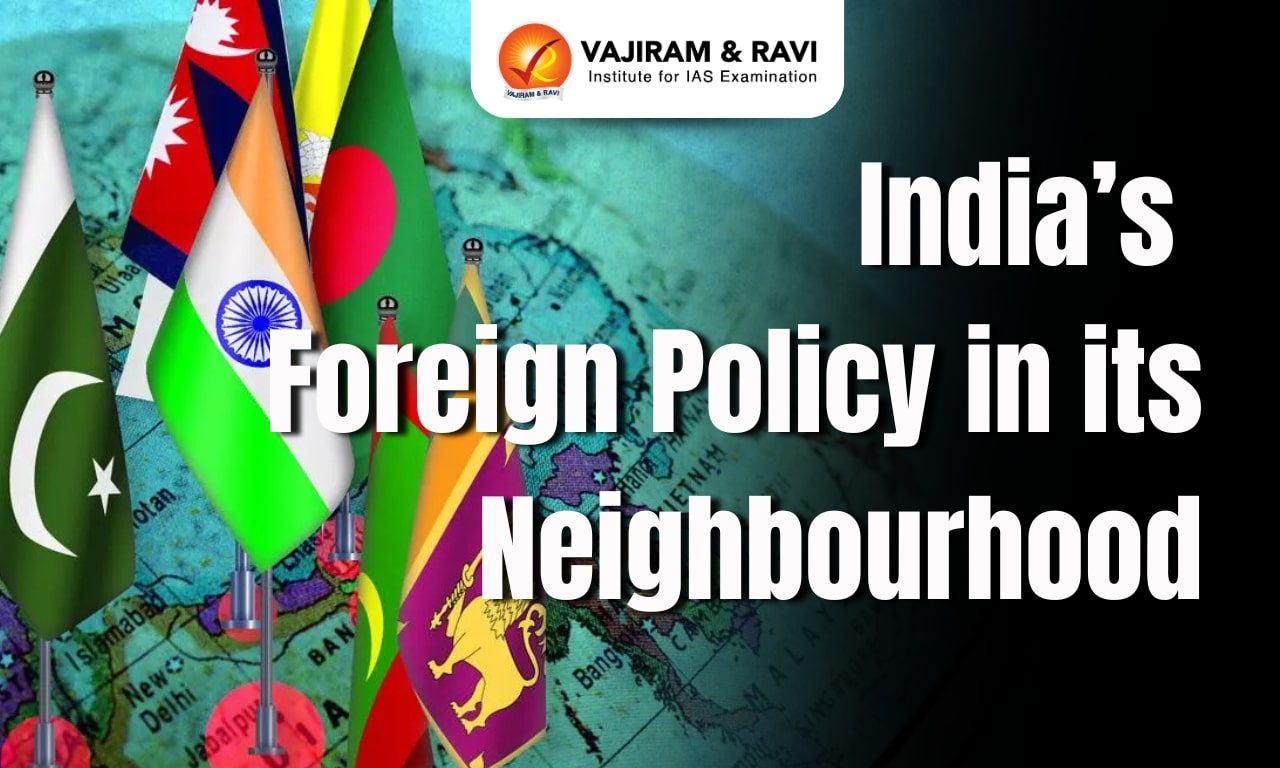What is International Solar Alliance (ISA)?
The International Solar Alliance (ISA) is an intergovernmental organization that was launched in 2015, by the Prime Minister of India and the President of France, at the United Nations Climate Change Conference held in Paris.
- ISA is an action-oriented, member-driven, collaborative platform for increased deployment of solar energy technologies.
- The ISA is guided by its ‘Towards 1000’ strategy, which aims:
- To mobilize USD 1000 billion of investments in solar energy solutions by 2030
- To deliver energy access to 1000 million people using clean energy solutions
- To install 1000 GW of solar energy capacity.
- To mitigate global solar emissions to the tune of 1000 million tonnes of CO2 every year.
- Vision: Let us together make the sun brighter.
- Mission: Every home, no matter how far away, will have a light at home.
- Headquarter: National Institute of Solar Energy (NISE) in Gurugram, India.
What are the objectives and priority areas of ISA?
The key objectives of ISA are:
- To facilitate the deployment of 1000 GW of solar energy capacity globally by 2030.
- To mobilize more than US$1 trillion in investment for solar energy deployment in member countries by 2030.
- To develop innovative financial mechanisms to reduce the cost of solar energy deployment.
- To encourage research and development of solar energy technologies.
- To establish solar energy as a mainstream source of energy for all.
- Activities under the programmes focuses on 4 priority areas –
- Analytics & advocacy
- Capacity building
- Programmatic support
- Readiness and enabling activities
What is the governance structure of the ISA?
- ISA Assembly: It is the apex decision-making body that comprises representatives from each Member Country. The Assembly deliberates matters of substance, such as the selection of the Director General, the functioning of ISA, approval of the operating budget, etc.
- The first Assembly of the ISA was held in October 2018 in Greater Noida, India.
- Steering Committee: The Steering Committee is responsible for providing strategic guidance to the ISA and overseeing its operations. The Steering Committee meets to review progress and make recommendations to the Assembly.
- Secretariat: The Secretariat is the administrative arm of the ISA and is responsible for implementing the decisions of the Assembly and the Steering Committee.
- Head of ISA: It is headed by the Director General.
- The Director General leads the operations and carries out the functions of the ISA Secretariat.
- He is responsible for the ISA Assembly.
- Director general will have a tenure of 4 years, and he is eligible for reelection.
How did the ISA originate and evolve over time?
- ISA was conceived as a joint effort by India and France to mobilize efforts against climate change through the deployment of solar energy solutions.
- It was conceptualized on the sidelines of the COP21 to the United Nations Framework Convention on Climate Change (UNFCCC) held in Paris in 2015.
- With the amendment of its Framework Agreement in 2020, all member states of the United Nations are eligible to join the ISA. At present, more than 110 countries are signatories to the ISA Framework Agreement, of which 90 countries have submitted the necessary instruments of ratification to become full members of the ISA.
What is the importance of ISA?
For India
- Leadership in renewable energy: India has set an ambitious target of achieving 450 GW of renewable energy capacity by 2030. The ISA can help India in achieving this goal by promoting solar energy deployment in member countries.
- Soft power in the international arena: By taking a leadership role in the ISA, India can enhance its reputation as a responsible global player committed to sustainable development.
- Climate change adaptation: As a developing country, India is particularly vulnerable to the impacts of climate change, and the ISA can help India in its efforts to mitigate and adapt to climate change.
For the World
- Promoting clean energy: The ISA's main objective is to promote the use of solar energy as a clean, renewable, and sustainable source of energy. This is important to achieve climate change goals.
- Encouraging investment in solar energy: The ISA aims to mobilize over a trillion dollars of investment in solar energy by 2030. This can create new opportunities for businesses and stimulate economic growth.
- Supporting energy access: The ISA's focus on solar energy can help increase access to energy, particularly in rural and remote areas. This can contribute to poverty reduction and overall human development.
What are the various projects and initiatives of ISA?
Solar Technology Application Resource Centre [STAR C] Initiative
- ISA’s capacity-building and institutional strengthening initiative in developing member countries.
- STAR C initiative aims to cultivate the desired human capacity and skills among a member country’s populace to encourage the significant undertaking of energy transition activities, creating jobs and ultimately contributing to the country’s economic growth.
- They act as hubs of technology, knowledge, and expertise on solar energy and are a go-to place for a member country at the regional or country levels.
Indian Technical and Economic Cooperation (ITEC) Scheme
- The Government of India has been supporting the ISA by providing training to master trainers in the field of solar energy.
- The duration of the training is 21 days, and all costs are borne by the Government of India.
- In 2018-2019, 133 candidates from 25 countries were trained at the National Institute of Solar Energy, Gurugram, with the support of the ITEC programme.
ISA solar fellowship for mid-career professionals
- The objective is to contribute towards the long-term development needs of member countries through the creation of skilled and qualified professional manpower for the management of solar energy projects, programmes, and policies.
- Fellowships will be offered to mid-career professionals from ISA countries and the candidates would be expected to contribute towards policy development in their home country which in turn will help ISA achieve its objectives.
- 21 candidates from 18 ISA Member countries are currently pursuing Masters degrees in RE Management and Economics in the first batch that commenced on 22 July 2019.
One Sun, One World, One Grid (OSOWOG) initiative
- The idea for the One Sun, One World, One Grid (OSOWOG) initiative was put forth by India in 2018. The initiative aims at connecting energy supply across borders.
- The vision behind the OSOWOG initiative is the mantra that “the sun never sets”. The OSOWOG initiative aims to connect different regional grids through a common grid that will be used to transfer renewable energy power and, thus, realize the potential of renewable energy sources, especially solar energy.
Various other project themes
- Affordable finance at scale: To make solar power more accessible and affordable through innovative financing mechanisms such as the Green Climate Fund and the World Bank's International Finance Corporation.
- Mini-grids: The ISA is promoting the development of mini-grids powered by solar energy to provide access to electricity to communities that are off-grid or have limited access to electricity.
- Various other projects relating to solar agriculture pumps, solar rooftop installations, solar water heaters, solar street lighting, etc.
What are the challenges and limitations of the ISA?
While the ISA has made significant progress since its inception, there are several challenges associated with the organization, including
- Funding: While the organization has received support from various countries, including France and India, it requires significant financial resources to achieve its objectives of promoting solar energy in developing countries.
- Limited participation: Currently, more than 100 countries have signed the ISA Framework Agreement, which is significantly lower than the total number of countries in the world, and it limits the ISA's ability to achieve its objectives and expand its impact.
- Policy coordination: Countries have different energy policies and regulations, making it challenging to harmonize them and create a level playing field for solar energy.
- Implementation: Implementation of solar energy projects can be challenging due to factors such as lack of infrastructure, political instability, and inadequate financing, and it leads to a lack of successful implementation of its projects.
How can ISA effectively steer its future course of action?
To effectively steer its future course of action, ISA can consider the following strategies:
- Increase collaboration: The collaboration with international organizations, governments, and private sector entities will help the organization leverage resources and expertise in the solar energy sector.
- Expand membership: Expand the membership by engaging with more countries, especially those that have a high potential for solar energy. This can help to increase the reach and impact of the organization.
- Implement policy reforms: Focus on implementing policy reforms in member countries to remove barriers to the adoption of solar energy by including providing incentives and reducing subsidies for fossil fuels.
- Facilitate financing: ISA can facilitate financing for solar energy projects in member countries by establishing a fund or working with international financial institutions.
- Foster innovation: ISA can encourage and promote innovation in the solar energy sector by supporting research and development activities and providing a platform for sharing best practices and knowledge.
Last updated on December, 2025
→ Check out the latest UPSC Syllabus 2026 here.
→ Join Vajiram & Ravi’s Interview Guidance Programme for expert help to crack your final UPSC stage.
→ UPSC Mains Result 2025 is now out.
→ UPSC Notification 2026 is scheduled to be released on January 14, 2026.
→ UPSC Calendar 2026 is released on 15th May, 2025.
→ The UPSC Vacancy 2025 were released 1129, out of which 979 were for UPSC CSE and remaining 150 are for UPSC IFoS.
→ UPSC Prelims 2026 will be conducted on 24th May, 2026 & UPSC Mains 2026 will be conducted on 21st August 2026.
→ The UPSC Selection Process is of 3 stages-Prelims, Mains and Interview.
→ UPSC Result 2024 is released with latest UPSC Marksheet 2024. Check Now!
→ UPSC Prelims Result 2025 is out now for the CSE held on 25 May 2025.
→ UPSC Toppers List 2024 is released now. Shakti Dubey is UPSC AIR 1 2024 Topper.
→ UPSC Prelims Question Paper 2025 and Unofficial Prelims Answer Key 2025 are available now.
→ UPSC Mains Question Paper 2025 is out for Essay, GS 1, 2, 3 & GS 4.
→ UPSC Mains Indian Language Question Paper 2025 is now out.
→ UPSC Mains Optional Question Paper 2025 is now out.
→ Also check Best IAS Coaching in Delhi
International Solar Alliance FAQs
Q1. Is the International Solar Alliance (ISA) part of the United Nations?+
Q2. Where is the headquarters of ISA?+

















